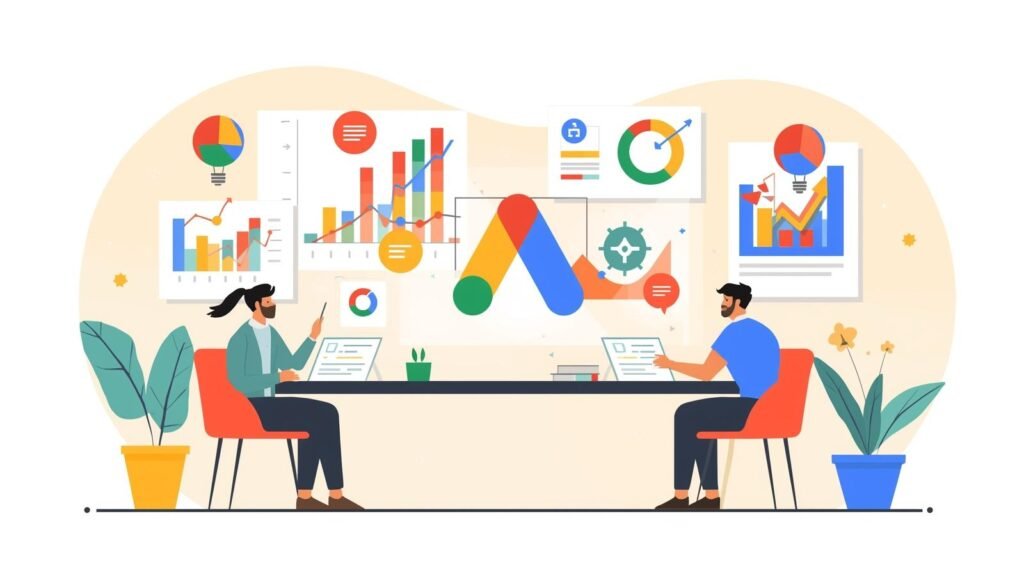Introduction: Why a Google Ads Agency Strategy Matters
In 2025, Google Ads is still the backbone of paid search marketing. Businesses of all sizes—from small local shops to enterprise-level corporations—rely on it to capture customers at the moment they’re ready to buy. But despite its power, Google Ads is not a “set and forget” platform. Poorly managed campaigns drain budgets quickly, while smartly executed ones drive exponential growth.
That’s why agencies develop a Google Ads agency strategy: a structured approach to research, campaign setup, testing, optimisation, and scaling. It’s not just about bidding on keywords—it’s about aligning advertising with business objectives, audience intent, and data-driven insights.
This guide explores how agencies design strategies that consistently outperform DIY campaigns. We’ll cover:
-
The building blocks of an effective Google Ads strategy.
-
How agencies tailor approaches to different industries.
-
Step-by-step processes from setup to scaling.
-
Tools and tactics agencies rely on in 2025.
-
Common mistakes to avoid.
-
FAQs for businesses considering professional PPC help.
By the end, you’ll see why partnering with a Google Ads agency—and following their strategic framework—is one of the smartest investments you can make.
The Core Components of a Google Ads Agency Strategy
A great strategy starts with a strong foundation. Agencies know that success in PPC comes from aligning campaigns with both technical best practices and broader business goals.
1. Business & Market Analysis
-
Understanding the client’s goals (leads, sales, brand awareness).
-
Analysing competitors’ ad copy, keywords, and budgets.
-
Reviewing industry benchmarks for CPC and conversion rates.
2. Keyword Research & Audience Targeting
-
Building portfolios of high-intent keywords.
-
Balancing broad, phrase, and exact match types.
-
Segmenting audiences by demographics, interests, and behaviours.
3. Campaign Structuring
-
Creating tightly themed ad groups.
-
Aligning ad copy with keywords for higher Quality Scores.
-
Using campaign segmentation (by product, service, or location).
4. Ad Copy & Creative Development
-
Writing persuasive ads with clear CTAs.
-
Designing responsive display and video creatives.
-
Testing multiple versions for performance.
5. Conversion Tracking Setup
-
Implementing GA4 and Google Tag Manager.
-
Tracking forms, calls, eCommerce transactions.
-
Using Enhanced Conversions for accuracy.
6. Bid & Budget Management
-
Leveraging Smart Bidding strategies (Target CPA, Target ROAS).
-
Adjusting bids by device, location, and audience.
-
Allocating budgets to top-performing campaigns.
7. Optimisation Cycles
-
Weekly negative keyword updates.
-
A/B testing landing pages.
-
Refreshing creatives to prevent fatigue.
8. Reporting & Insights
-
ROI-focused dashboards (Looker Studio).
-
Transparent monthly reporting.
-
Actionable recommendations for scaling.
This framework ensures campaigns don’t just generate clicks—they deliver measurable ROI.
Step-by-Step Process of a Google Ads Agency Strategy
Agencies typically follow a clear process to build and refine campaigns:
Step 1: Discovery & Audit
-
Review historical account performance.
-
Identify wasted spend and missed opportunities.
-
Benchmark against competitors.
Step 2: Strategy Development
-
Define primary KPIs (CPA, ROAS, lead volume).
-
Select campaign types (Search, Display, Shopping, YouTube, Performance Max).
-
Build audience personas.
Step 3: Campaign Setup
-
Structure campaigns around services or products.
-
Write ad copy aligned with keyword intent.
-
Add ad extensions (sitelinks, callouts, snippets).
-
Build optimised landing pages.
Step 4: Tracking & Attribution
-
Install GA4 + Tag Manager.
-
Enable Enhanced Conversions.
-
Attribute revenue to specific campaigns and keywords.
Step 5: Optimisation & Scaling
-
Weekly bid adjustments.
-
Adding new keyword opportunities.
-
Expanding into remarketing and cross-channel campaigns.
-
Scaling top performers with increased budgets.
Step 6: Reporting & Strategic Adjustments
-
Deliver monthly reports with ROI breakdowns.
-
Provide recommendations for expansion.
-
Refine long-term strategy based on performance data.
This structured process turns PPC into a predictable growth engine.
Industry-Specific Google Ads Strategies
Agencies tailor strategies depending on the client’s niche.
1. eCommerce
-
Shopping campaigns with optimised product feeds.
-
Performance Max campaigns for cross-network reach.
-
Dynamic remarketing for cart abandoners.
2. Local Services
-
Call-only ads for quick leads.
-
Geo-targeting within service areas.
-
Negative keywords to cut wasted spend.
3. B2B & SaaS
-
LinkedIn audience integration.
-
Lead generation campaigns for free trials or demos.
-
Content-driven remarketing on YouTube.
4. Healthcare & Legal
-
Compliance-focused ad copy.
-
Targeting urgent, high-intent keywords.
-
Local service ads with call tracking.
Each sector requires its own strategy—generic campaigns rarely succeed.

Tools Agencies Use to Build Strategies
-
Google Ads Manager – Campaign creation & optimisation.
-
Google Analytics 4 (GA4) – Conversion tracking.
-
Optmyzr – Automated bidding and reporting.
-
SEMrush / Ahrefs – Keyword and competitor insights.
-
CallRail – Phone call attribution.
-
Looker Studio – Custom dashboards.
-
Unbounce / Instapage – Landing page optimisation.
These tools allow agencies to make data-driven decisions and maximise ROI.
Common Mistakes Businesses Make Without a Strategy
-
Running broad match keywords with no negatives.
-
Sending traffic to generic homepages instead of targeted landing pages.
-
Ignoring conversion tracking.
-
Failing to refresh ad creatives.
-
Overlooking remarketing opportunities.
-
Not adjusting campaigns for seasonality.
A professional agency strategy prevents these costly mistakes.
Costs of a Google Ads Agency Strategy in 2025
Pricing varies depending on complexity, but average costs include:
-
Small Businesses (Local): £800–£1,500/month.
-
Medium Businesses (Regional/National): £2,000–£5,000/month.
-
Enterprise Brands (International): £10,000+/month.
Models include flat fees, % of ad spend (10–20%), or performance-based pricing.
Conclusion: Why a Google Ads Agency Strategy Is Essential
In 2025, Google Ads is too competitive and complex to manage without a plan. A Google Ads agency strategy ensures campaigns are data-driven, ROI-focused, and aligned with business goals.
From account structure and keyword targeting to ongoing optimisation and scaling, agencies provide the roadmap to profitable growth. For businesses serious about maximising returns, a professional strategy isn’t optional—it’s essential.
The bottom line: strategy transforms Google Ads from a risky expense into a reliable growth engine. Partnering with an agency that knows how to craft and execute it can make all the difference.
FAQ
Most frequent questions and answers
Initial results can appear within weeks, but consistent ROI typically takes 2–3 months
Yes—even £1,000/month ad spend can deliver results with the right structure.
Always—remarketing converts warm leads into customers.
Yes—most provide monthly ROI-focused reports with insights.
Track KPIs like CPA, ROAS, and lead quality over time.
Also, read: –
- Digital Marketing Agency: Expectations vs. Reality
- What are SEO Services and Why Do they Matter?
- Why We Love Google Ads service (And You Should, Too!)
- The Next Big Thing in Digital Marketing Services
- Getting the most out of your Web Design Company UK
- Why Nobody Cares About Domain Name Search
- Meet the Steve Jobs of the Web Design Company


